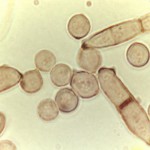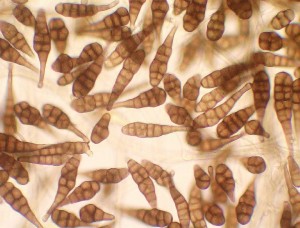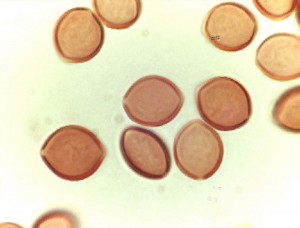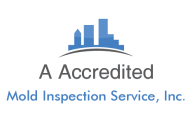MOLD SPORE LEVEL INFORMATION FOR MOLD INSPECTORS
Mold inspectors cannot give one single number of spores that can be considered an elevated level in every situation.

Cladosporium mold is extremely common indoors and out. It loves to grow on low nutrient surfaces like metal, fiberglass, and concrete. Common inside AC units and duct.
However our inspector who is certified to conduct mold inspections, mold testing, and microscopic spore analysis in South Florida has provided some information on spore levels. If you need a mold inspection provided by our mold inspectors click here. If you just want information on mold spore levels keep reading.
DEFINITIONS
Remember that > means greater than or more than.
Remember that CFU means colony forming units or spores.
So >1,000 CFU mean more than 1,000 spores per cubic meter of air.
Ok now that you have a better grasp on nerd terminology you can keep reading.

Tetrapola mold spores float on the surface of freshwater streams and ponds. Rarely found by mold inspectors during indoor sampling.
Occupational Safety and Health Administration, OSHA 1992 findings.
1,000 spores per cubic meter of air is indicative of high spore levels.
American Conference of Governmental Industrial Hygienists 1993.
1,000 spores per cubic meter of air is indicative of high spore levels.
Air Sampling Instruments for Evaluation of Atmospheric Contaminants 1995.
100 cfu or less per cubic meter of air is low.
100 cfu to 1000 cfu per cubic meter of air is intermediate.
1000 or more cfu per cubic meter of air is high.
Much of the below information is from Worldwide Mold Exposure Standards for Mold and Bacteria, Robert C. Brandys, PhD, MPH, PE, CIH, CSP, CMR and Gail M. Brandys, MS, CSP, CMR:
Brazil Government Findings 2002
100-500 normal indoor mold spore levels per cubic meter of air.
Norway Government Findings
<750 acceptable.
Czech Republic 2000 Findings
2,000 or more spores per cubic meter of air will likely lead to health complaints.
American Academy of Allergy, Asthma and Immunology/National Allergy Bureau findings 2002
1 – 6,499 Low- Only individuals extremely sensitive to these pollens and molds will experience symptoms.
6,500 – 12,999 Moderate – Many individuals sensitive to these pollens and molds will experience symptoms.
13,000-49,999 High Most individuals with any sensitivity to these pollens and molds will experience symptoms.
50,000 Very High – Almost all individuals with any sensitivity at all to these pollens and molds will experience symptoms.
Extremely sensitive people could have severe symptoms.
Please note that the above National Allergy Bureau findings are not trying to indicate what are expected spore levels, but what levels may affect various populations if exposed to such levels outdoors.
The American Conference of Government Industrial Hygienists (ACGIH)
Stated that if indoor spore levels are consistently more than double the outdoor levels, and if indoor spore levels exceed 1000 spores per cubic meter of air, you may have a problem and should investigate.
Caoimhín P. Connell. Industrial Hygienist and Mold Inspector

The above is a photo of Alternaria spores.
Though they do not often grow in large amounts
in water damaged buildings, a few of these spores
are not uncommon in both indoor and outdoor samples.
As a general rule, the normal indoor total fungal spore counts across the central portion of the U.S. (bounded by a latitude of, say, 35° north to 45° north), for healthy buildings (buildings not experiencing fungal problems) is usually less than 500 counts per cubic meter (counts/m3); with indoor concentrations exceeding 900 counts/m3 less than 15% of the time.
Industry Consensus Among Mold Inspectors, Mold Remediators, and Labs.
Despite all the above data, what most mold inspectors in the industry look at the most when analyzing spore levels is simply this: Mold spore levels indoors should be lower than outdoor levels. This is very widely accepted and the idea comes from a wide variety of sources. In addition to this rule, skilled mold inspectors also consider the fact that indoor levels should be in a reasonable range. The above data all seems to indicate reasonable ranges. Thus, indoor levels should be lower than outdoor levels, and they should be reasonable. Indoor spore levels should not be above several hundred or a thousand as the above reasonable data shows.
Here is some more recommended reference material on indoor spore levels for mold inspectors to check out:
*Worldwide Mold Exposure Standards for Mold and Bacteria, Robert C. Brandys, PhD, MPH, PE, CIH, CSP, CMR and Gail M. Brandys, MS, CSP, CMR.

Above are photos of Chaetomium spores. Like Stachybotrys, they require large amounts of water for growth. in water damaged homes the mold looks like cinnamon.
Above are conidiophores of Aspergillus,
these are not individual spores, but are
masses of spores formed around bulb shaped
structure that sit atop an elongated stalk.
Some Things for Mold Inspectors to Consider
The above information was not provided as final and definitive mold spore level specifications for mold inspectors to follow because health responses to mold spore exposures differ from person to person. Also, health responses to mold spores can be affected by the length of time you are exposed to spores, the size or type of spore you are exposed to, the levels of dust mite and roach allergens, individual sensitivity to allergens, emotional stress, general health, as well as other substances and factors that have not yet been discovered by mold inspectors. Thus, as a result mold spore levels alone at your property cannot always be relied on to always answer questions such as “Are molds in my environment making me sick.”
The above information is general helpful information and should not be relied on as medical advice.
For a mold inspector in your area contact us, but for medical advice please see your doctor.
By Daryl Watters
A Accredited Mold Inspection Service, Inc.
Need mold inspectors to sample and inspect your Southeast Florida property? Call us today.



